ADPC boasts over 14,000 graduates from its regional trainings worldwide. Today, ADPC alumni are playing leading roles in disaster risk reduction initiatives and interventions.
ADPC alumni belong to a worldwide community, that together forms an extensive network of international contacts from the United Nations agencies, local NGOs, international organizations (such as Red Cross and Red Crescent Societies, donor agencies and NGOs), government agencies, universities, private sector, resources survey and map production services, and various other international professional associations.
See what our alumni are doing today and how they have benefited from ADPC’s courses.
-
Alumni's experiences from Disaster Resilience Leadership course
ADPC's Disaster Resilience Leadership (LRD-2) course was organized in September 2013 in Bangkok. See the video on the participants experiences.
-
Nutrition in Emergencies (NIE-2)
Preventing malnutrition in flood-affected Punjab
UNICEF’s provincial office in Punjab, Pakistan is implementing various interventions to prevent and treat malnutrition in the province. Thanks to attending the Nutrition in Emergencies course in October 2012, I was selected as a member of the nutrition team.
One of the current programs implemented is Community Management of Acute Malnutrition (CMAM) to treat acute malnutrition in seven districts that were affected by the floods in 2010. The knowledge that I gained about the protocols of managing severe, moderate, and mild malnutrition during the Nutrition in Emergencies course, has helped me a lot. Also, the skills in calculating the needed nutrition supplies and knowledge on the sphere standards have been very useful. The course even gave me confidence in writing the funding proposal if the need arises.
I also now work as the emergency focal person for our section preparing a nutrition-related emergency preparedness and response plan as well as coordinating with our various cluster partners at the provincial level in case of any unforeseen emergency such as floods.
The training on nutrition in emergencies catered the needs of students coming from a variety of settings. The practical examples were enlightening, and the interaction and sharing of experience among the participants from different countries was commendable.
Dr. Qurrat-ul-Ain Ahmed works as Nutrition Officer at UNICEF Punjab in Pakistan.
-
Community-based disaster risk management (CBDRM)
Supporting community-based disaster risk reduction in Afghanistan
At the time of the community-based disaster risk management course in 2012, I worked as National Health Promotion and Disaster Risk Reduction Coordinator for the World Health Organization (WHO) in Afghanistan. I knew about Asian Disaster Preparedness Center’s long-term experience and expertise on community-based disaster risk management, and decided to attend the course.
In my work at World Health Organization, I led the development process of a community toolkit on disaster risk reduction for the Ministry of Public Health Afghanistan. The course improved my ability to better contribute to the development process. During the training I also learned more about the climate change and its linkages to public health risks, which was very useful to me.
I found the course as a great venue to gain the latest knowledge on community-based disaster risk management and to learn about the current practices in the field. It was also a great opportunity for networking. The course helps the participants to further contribute in the implementation of community-based disaster risk reduction and to improve the situation in their countries.
Later in 2012, Dr. Pir Mohammad Paya joined Asian Disaster Preparedness Center as a senior technical specialist.
-
Nutrition in Emergencies
Spreading knowledge on Nutrition in Emergencies in the Philippines
Since I am a graduate of the Nutrition in Emergencies (NiE) course in 2011 and took part in the conduct of NiE in 2012, the Department of Health of the Government of the Philippines has integrated new knowledge on nutrition in emergencies to a number of its guidelines and publications. Developed in cooperation with the department’s cluster and sectoral partners, these include the following: Pocket Emergency Tool for Nutrition in Emergencies, Training Manual on Nutrition in Emergencies for the local government, Treatment Protocol for Selected Conditions and Diseases during Emergencies, and Key Health Messages for Emergencies.
The new knowledge and skills gained in the course are valuable also when I provide technical assistance in the capability development activities and the actual delivery of nutrition in emergency response interventions in the country. Our department supports the Nutrition Cluster of the Philippines in the finalization of the Integrated Information Management System for Health Emergency Management where technical inputs learned from the NiE course are utilized.
During the running of the course, it will be helpful that for every session participants with field experience from certain areas can be requested to share lessons and best practices as a jumpstart towards a more comprehensive discussion. The course even helped me in developing my management skills that are needed in program management, monitoring and evaluation at the national level; communication skills that are important in coordinating cluster concerns on nutrition; and technical skills needed in developing strategies on how to advocate for cluster support and improve mechanisms for services delivery.
Ms. Florinda Venzon Panlilio works as Nutritionist Dietitian IV at Health Emergency Management Staff of Department of Health of the Government of the Philippines.
-
Geographic Information Systems (GIS) for Disaster Risk Management
Using spatial data for disaster risk management
I attended ADPC’s Training Course on Geographic Information Systems (GIS) for Disaster Risk Management in 2015. The training improved my understanding of how GIS is used in different organizations – during both pre- and post-disaster management – and I am more comfortable using this software now that I got to practice. The introduction to the technology was useful and interesting, and the resources and references were excellent. I really appreciated the time we had for the hands-on exercises and the context of using real-life situations. I like the way ADPC started the training from the basics, and the fact that the training engaged a diverse group of people from different organizations working on a multitude of environmental projects.
I later also participated in ADPC’s Training Course on Incident Command Systems (ICS) for Disaster Management, which provided in-depth knowledge on the application of ICS in disaster response management. I learned, among other things, about the importance of having clear roles and reporting structures in times of emergencies.
The courses relate very much to my work with the local and regional offices of the United Nations Development Programme in Thailand, within the framework of development under the environment portfolio, specifically focusing on energy consumption and energy efficiency, low carbon development, and development of project proposals on topics such as medical waste recycling. I also support other country offices in managing the development of projects related to recovery from natural disasters in Southeast Asia.
Being prepared for disasters entails engaging the community at all levels – from professionals in international organizations and government bodies to the local communities – without dismissing the affected communities’ existing knowledge that in turn adds to the sense of belonging and security. We promote the idea that resilience should be integrated into every new development initiative and that preparedness is everyone’s responsibility.
Meshal Abdullah works as Programme Analyst at the United Nations Development Programme office in Thailand. -
Managing Risk in the Face of Climate Change
Mr. Navneet Yadav
“Understanding the key concepts of disaster risk reduction and climate change adaptation was my motivation for participating in this training course as my organization works towards climate-resilient and disaster-ready communities.
I didn’t expect to learn one-size-fits-all disaster risk management approaches and frameworks. I understand we cannot simply take one strategy and apply it everywhere. A framework might work for disaster risk reduction hotspots like the Philippines or Bangladesh, but not necessarily for my country.
During the training, we were provided with various disaster risk reduction methodologies, learned how to mainstream climate change and disaster risk reduction into planning and then decided which approach to adopt according to specific contexts to ultimately enhance community resilience.
Over the past 12 years, I have been working in the Himalayan region. Even though the training course discussed hazards affecting coastal regions, the diverse group work was very beneficial to me as everyone brought their own set of knowledge from different countries around the world. When I discussed an issue in my region someone else reported they had similar challenges and we worked together to find the best solutions.
During the training facilitators demonstrated their inherited values, shared their experience of being in a disaster themselves, and reminded us why we are doing the work we do. They made sure we can do our job in the most effective way possible, and I’m very thankful for that.
Everyone at the training has graduated from universities, worked on disaster risk reduction concepts for a long time and understands the theory behind them. The facilitators’ role was not only to teach us new concepts, but also teach us how to apply the knowledge we already know to bring about meaningful change.DRR and CCA cannot be mainstreamed without that sense of commitment and empathy towards the community that these two approaches intend to serve.”
Mr. Navneet Yadav works at Doers in the Himalayan region of India
-
Country Coordinator supporting the PMI implementing
Awaluddin
Testimonial:
"Learning together at ADPC is really fun with well trained and experienced instructors, learning theory in practical way and sharing experiences from fellow participants from different countries. Good luck and keep being "home of knowledge" for humanity."
I have participated in the 22nd Regional Training Course on Community-Based Disaster Risk Reduction with a Climate Change (CBDRR-22) since 2013. In that time I worked in Japanese Red cross Society (JRCS) Indonesia Delegation as a Program Manager. I was given a great opportunity to learn DRR through CBDRR Course with ADPC after getting basic course in Indonesia together with the Indonesian Red Cross (PMI) team.
Recently I am still working with the JRCS Indonesia Delegation and promoted as the Country Coordinator supporting the PMI implementing the second phase of Integrated Community Based Risk Reduction in Bengkulu Province, Sumatera Island. We are supporting 9 communities focusing on Earthquake and Tsunami. This is a 4 years project starting from April 2016 to March 2020 after completion of the similar project in Banten Province.
Based on what I learned from ADPC, recently we have completed the Baseline Survey, VCA and Risk Mapping, the progress will be continued by the preparation and development of Village Risk Reduction Plan in 9 communities together with community volunteers called Community Based Action Team (CBAT).
-
Health Specialist (Emergency), UNICEF, Sudan Country Office
Dr. Shaza Ahmed Sidahmed
It was really useful to attend the GIS for disaster risk management course organized by the ADPC in 2012. Actually, everything was wonderful; the training's venue, the module and training materials ,and the facilitation techniques. I have learnt a lot from this course because the facilitators were very knowledgeable and supportive. I highly recommend this very course to all professionals working in management of information related to the disasters risk assessment and management . Thanks to ADPC for offering such an excellent learning's opportunity.
-
4th Online Training Course on Disaster Risk Communication
Mr. Shuvo Kumar Saha
I would like to extend my appreciation to ADPC for this training. This course is interactive and we were able to share the knowledge and experience with fellow participants from other parts of the world on disaster risk communication processes. I also personally thank ADPC, particularly on selection of participants for my group with some government officials and UN agency guys. We learned a lot and we were able to develop the DRC plan together well.
-
4th Online Training Course on Disaster Risk Communication
Ms. Grace Tsz Kwan Yip
Overall, I think this course is very timely, especially for us during the COVID-19 pandemic situation. It will help me a lot at work in Hong Kong Adventist Hospital and it will help reduced the knowledge gap because I think it was an obstacle or challenge coming up with impact and quick DRC plan. For the course content, I am very appreciative because it is very active with expert advise and handling. Well organized.
-
Ogulgerek Annayeva, SERVIR Southeast Asia | July 20, 2024
Cambodian conservationist customizes geospatial tools to protect forests and wildlife
Ogulgerek Annayeva, SERVIR Southeast Asia | July 20, 2024
Sonsak Nay grew up in Cambodia's Kampong Chhnang province, located 70 km from the capital Phnom Penh, where he developed a profound connection to nature and a desire to protect the landscape.
"My family instilled in me a deep respect for the environment, always taking care to protect the natural landscapes," he says.
"In my childhood, I was surrounded by lush green forests, vibrant birds, and cascading waterfalls. These experiences shaped my dreams and ignited a lifelong dedication to protect our forest landscapes and the incredible wildlife they harbor.Ogulgerek Annayeva, SERVIR Southeast Asia | July 20, 2024
Sonsak Nay grew up in Cambodia's Kampong Chhnang province, located 70 km from the capital Phnom Penh, where he developed a profound connection to nature and a desire to protect the landscape.
"My family instilled in me a deep respect for the environment, always taking care to protect the natural landscapes," he says.
"In my childhood, I was surrounded by lush green forests, vibrant birds, and cascading waterfalls. These experiences shaped my dreams and ignited a lifelong dedication to protect our forest landscapes and the incredible wildlife they harbor.
Cambodia is home to renowned wildlife sanctuaries and national parks, but the country is losing much of its protected land each year.
Sonsak started working as a GIS analyst at the Wildlife Conservation Society (WCS) in Phnom Penh in 2013, combining his technical skills with his commitment to environmental protection.
"In my early career years working with geospatial information at the WCS, I began to realize that the impact of deforestation is beyond wildlife conservation. I observed how the loss of forests contributed to the decline of biodiversity and the reduction of crucial carbon sinks. It was a turning point for me, that's when I started to search for solutions to address both conservation and climate change," says Sonsak, adding that non-action could lead to the loss of ecosystems and diverse wildlife of Cambodia.
Discovering SERVIR geospatial tools
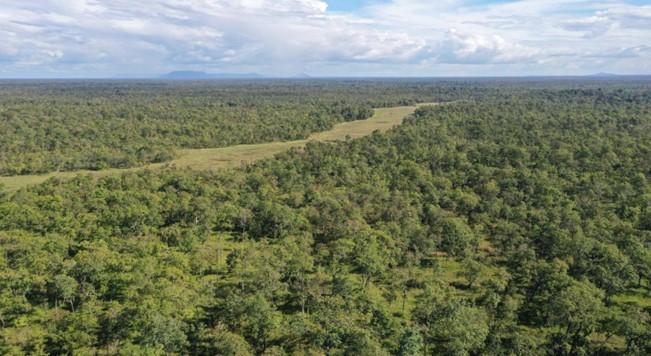 While
searching for solutions to address conservation challenges, Sonsak encountered the
SERVIR Mekong (now SERVIR Southeast Asia) team and became acquainted with their
geospatial tools.
While
searching for solutions to address conservation challenges, Sonsak encountered the
SERVIR Mekong (now SERVIR Southeast Asia) team and became acquainted with their
geospatial tools. 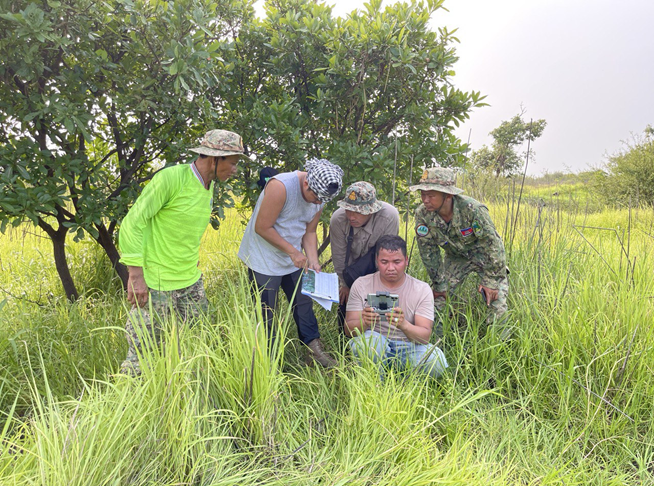 Sonsak
Nay with his co-workers during the field work. Photo Credit: Chea Monysocheata,
Geospatial Specialist, WCS
Sonsak
Nay with his co-workers during the field work. Photo Credit: Chea Monysocheata,
Geospatial Specialist, WCS "I learned from the SERVIR team how to use the application development tools to process and analyze geospatial data and support decision-making in areas such as agriculture, water resources, and land use."
Sonsak needed data on the size, location, and ecological impacts of deforestation. He sought tools to conduct a deeper analysis of how deforestation was affecting the environment, air quality, biomass, and carbon accumulation that otherwise would have been absorbed by the forests.
"Faced with a lack of comprehensive data on deforestation and its impacts, I began accumulating data and particularly focusing on satellite imagery and historical records. For our REDD+ project (Reducing Emissions from Deforestation and Forest Degradation), I analyzed historical records starting from 1990. Historical records/data provided insights into how deforestation has changed over time, and allowed me to identify trends, patterns, and drivers of deforestation."
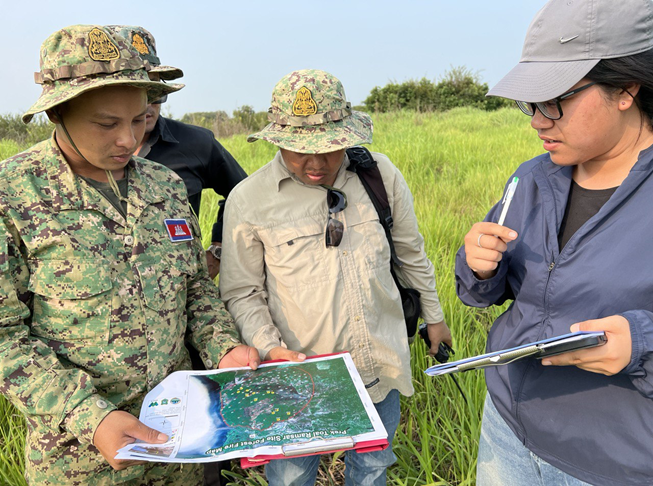 Sonsak
Nay with his co-workers during the field work. Photo Credit: Chea Monysocheata,
Geospatial Specialist, WCS
Sonsak
Nay with his co-workers during the field work. Photo Credit: Chea Monysocheata,
Geospatial Specialist, WCS In 2021, Sonsak participated in a technical training organized by SERVIR Southeast Asia. He learned more about satellite image preprocessing, machine learning, forest cover maps, and crop cover map algorithms. Specifically, he started using the SERVIR-supported Biophysical Monitoring & Evaluation Dashboard. "The Biophysical Monitoring & Evaluation Dashboard] provided me with more detailed, accurate data on forest cover, land use changes, and biodiversity indicators specifically for my project area. As a result, I was able to create a dataset, which made it much easier to identify higher-risk zones."
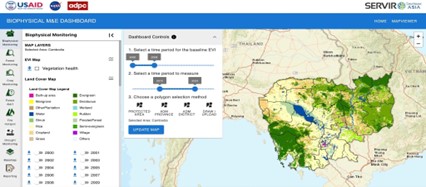
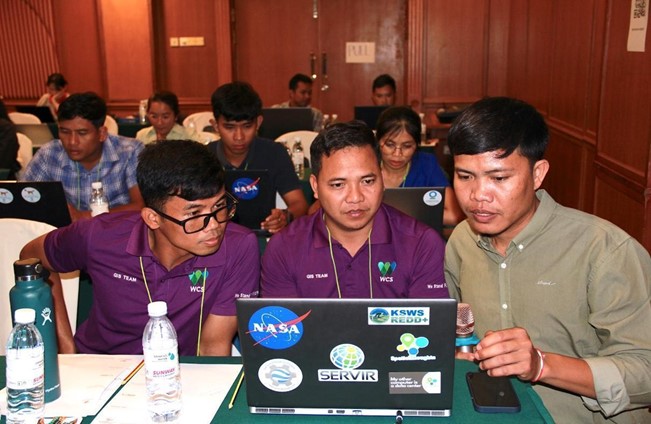 Sonsak
Nay with his team members during the SERVIR SEA crop mapping training in Phnom Penh,
Cambodia. Credit: ADPC
Sonsak
Nay with his team members during the SERVIR SEA crop mapping training in Phnom Penh,
Cambodia. Credit: ADPC With this new data, Sonsak could now alert the WCS management to take timely interventions and compile monthly reports for the Cambodian Forest Ground Patrol. This information helped the Patrol to effectively target their interventions, such as increased community engagement in at-risk areas.
Sonsak's dataset is used annually to prepare WCS reports for the Cambodian government, supporting the Cambodian Sustainable Management Plan.Continuing to learn and adapt
This year, Sonsak attended a SERVIR training on crop mapping applications with Google Earth Engine. Participants learned to use geospatial information for monitoring and mitigating deforestation linked to agriculture.
"By understanding the extent of deforestation for agriculture, we can inform the Cambodian government and promote sustainable farming practices that minimize the need for further deforestation," Sonsak said.
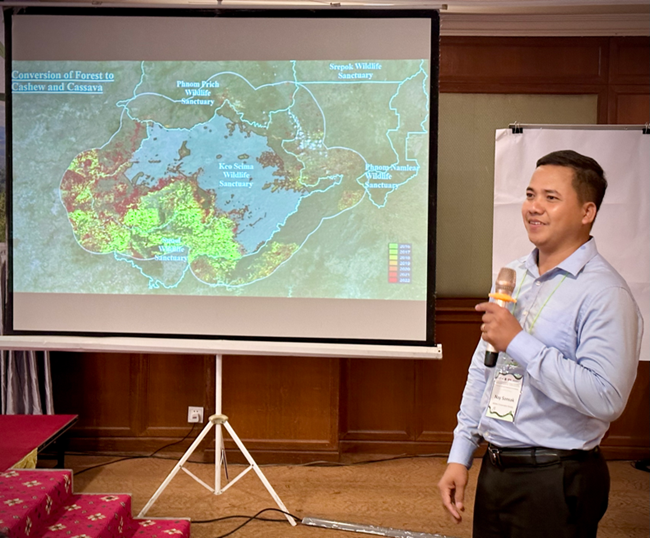 Sonsak
Nay's presentation at the SERVIR SEA workshop in Phnom Penh, Cambodia, held 22-25
April. Credit: ADPC
Sonsak
Nay's presentation at the SERVIR SEA workshop in Phnom Penh, Cambodia, held 22-25
April. Credit: ADPC SERVIR SEA strives to amplify positive impacts across Southeast Asia and envisions a future where well-equipped local individuals use geospatial data & tools and have a sense of ownership to enhance local resilience.
SERVIR SEA is a partnership between the U.S. Agency for International Development (USAID), U.S. National Aeronautics and Space Administration (NASA), and the Asian Disaster Preparedness Center (ADPC) -- uses publicly available satellite technologies and geospatial data to help communities across Southeast Asia adapt to regional and transboundary climate issues and mitigate the impacts of climate change.
For more information: https://servir.adpc.net | https://servir.adpc.net/tools
Cambodia is home to renowned wildlife sanctuaries and national parks, but the country is losing much of its protected land each year.
Sonsak started working as a GIS analyst at the Wildlife Conservation Society (WCS) in Phnom Penh in 2013, combining his technical skills with his commitment to environmental protection.
"In my early career years working with geospatial information at the WCS, I began to realize that the impact of deforestation is beyond wildlife conservation. I observed how the loss of forests contributed to the decline of biodiversity and the reduction of crucial carbon sinks. It was a turning point for me, that's when I started to search for solutions to address both conservation and climate change," says Sonsak, adding that non-action could lead to the loss of ecosystems and diverse wildlife of Cambodia.
Discovering SERVIR geospatial tools
 While searching for solutions to address conservation challenges, Sonsak encountered the SERVIR Mekong (now SERVIR Southeast Asia) team and became acquainted with their geospatial tools.
While searching for solutions to address conservation challenges, Sonsak encountered the SERVIR Mekong (now SERVIR Southeast Asia) team and became acquainted with their geospatial tools.
 Sonsak Nay with his co-workers during the field work. Photo Credit: Chea Monysocheata, Geospatial Specialist, WCS
Sonsak Nay with his co-workers during the field work. Photo Credit: Chea Monysocheata, Geospatial Specialist, WCS
"I learned from the SERVIR team how to use the application development tools to process and analyze geospatial data and support decision-making in areas such as agriculture, water resources, and land use."
Sonsak needed data on the size, location, and ecological impacts of deforestation. He sought tools to conduct a deeper analysis of how deforestation was affecting the environment, air quality, biomass, and carbon accumulation that otherwise would have been absorbed by the forests.
"Faced with a lack of comprehensive data on deforestation and its impacts, I began accumulating data and particularly focusing on satellite imagery and historical records. For our REDD+ project (Reducing Emissions from Deforestation and Forest Degradation), I analyzed historical records starting from 1990. Historical records/data provided insights into how deforestation has changed over time, and allowed me to identify trends, patterns, and drivers of deforestation."
 Sonsak Nay with his co-workers during the field work. Photo Credit: Chea Monysocheata, Geospatial Specialist, WCS
Sonsak Nay with his co-workers during the field work. Photo Credit: Chea Monysocheata, Geospatial Specialist, WCS
In 2021, Sonsak participated in a technical training organized by SERVIR Southeast Asia. He learned more about satellite image preprocessing, machine learning, forest cover maps, and crop cover map algorithms. Specifically, he started using the SERVIR-supported Biophysical Monitoring & Evaluation Dashboard. "The Biophysical Monitoring & Evaluation Dashboard] provided me with more detailed, accurate data on forest cover, land use changes, and biodiversity indicators specifically for my project area. As a result, I was able to create a dataset, which made it much easier to identify higher-risk zones."

 Sonsak Nay with his team members during the SERVIR SEA crop mapping training in Phnom Penh, Cambodia. Credit: ADPC
Sonsak Nay with his team members during the SERVIR SEA crop mapping training in Phnom Penh, Cambodia. Credit: ADPC
With this new data, Sonsak could now alert the WCS management to take timely interventions and compile monthly reports for the Cambodian Forest Ground Patrol. This information helped the Patrol to effectively target their interventions, such as increased community engagement in at-risk areas.
Sonsak's dataset is used annually to prepare WCS reports for the Cambodian government, supporting the Cambodian Sustainable Management Plan.Continuing to learn and adapt
This year, Sonsak attended a SERVIR training on crop mapping applications with Google Earth Engine. Participants learned to use geospatial information for monitoring and mitigating deforestation linked to agriculture.
"By understanding the extent of deforestation for agriculture, we can inform the Cambodian government and promote sustainable farming practices that minimize the need for further deforestation," Sonsak said.
 Sonsak Nay's presentation at the SERVIR SEA workshop in Phnom Penh, Cambodia, held 22-25 April. Credit: ADPC
Sonsak Nay's presentation at the SERVIR SEA workshop in Phnom Penh, Cambodia, held 22-25 April. Credit: ADPC
SERVIR SEA strives to amplify positive impacts across Southeast Asia and envisions a future where well-equipped local individuals use geospatial data & tools and have a sense of ownership to enhance local resilience.
SERVIR SEA is a partnership between the U.S. Agency for International Development (USAID), U.S. National Aeronautics and Space Administration (NASA), and the Asian Disaster Preparedness Center (ADPC) -- uses publicly available satellite technologies and geospatial data to help communities across Southeast Asia adapt to regional and transboundary climate issues and mitigate the impacts of climate change.
For more information: https://servir.adpc.net | https://servir.adpc.net/tools
-
An NGO Worker's Efforts Toward Building Disability-Inclusive Disaster Response in Kurigram, Bangladesh
Kamola Rani Paul, a seasoned disaster management professional, has dedicated her life to supporting vulnerable communities in the flood-prone district of Kurigram in Bangladesh. Now 64 years old, she works as a monitoring officer for SOLIDARITY, a non-government organization (NGO) that serves over 35,000 individuals in the region.
Born and raised in Kurigram, Kamola has always felt a deep connection to her community. The region is highly vulnerable to a range of disasters caused by natural hazards, including floods, river erosion, droughts, and extreme cold waves. 'জন্মের পর থেকে এ এলাকার মানুষ কতটা দুর্যোগে বিপন্ন তা আমি স্বচোক্ষে দেখেছি ( "Since my childhood, I've witnessed how vulnerable people in these areas can be,)" she recalls. This personal connection, along with the opportunity to participate in exclusive training focused on people with disabilities, has fueled her determination to make a difference in her community.
Kamola has been working in disaster management for over 30 years, but until recently, she had never received training focused on supporting people with disabilities. আমি ২০০৭ সাল থেকে দুর্যোগের ওপর কাজ করছি, নানা প্রশিক্ষণ দিয়েছি ও পেয়েছি কিন্তু প্রতিবন্ধী ব্যক্তিদের ওপর এ রকম পুর্ণাঙ্গ কোনো ট্রেনিং আমি কখনোই পাইনি ( "I have been working on disaster management since 2007 and have given and received various trainings, but I have never encountered such an inclusive training specifically for persons with disabilities,)" she explained.
 Kamola, along with her counterparts, attentively
receives guidance from the trainer — demonstrating focus, collaboration, and a strong
eagerness to learn. A great moment of growth in action!
Kamola, along with her counterparts, attentively
receives guidance from the trainer — demonstrating focus, collaboration, and a strong
eagerness to learn. A great moment of growth in action! When Kamola attended a three-day Disability-Inclusive Search, Rescue, and Evacuation (DISRE) training under the Bangladesh Preparedness Partnership (BPP), she found it incredibly insightful. BPP is led by the Ministry of Disaster Management and Relief (MoDMR) in Bangladesh, with technical assistance from the Asian Disaster Preparedness Center (ADPC) and funding from the Gates Foundation. BPP is a strategic and innovative initiative designed to support the Government of Bangladesh in implementing its flagship policy, the Standing Orders on Disaster (SOD) 2019, through a multi-stakeholder partnership model at the national and sub-national level. This program seeks to strengthen disaster management coordination across the country by employing a holistic "whole-of-society" approach. By uniting government agencies, non-governmental organizations, civil society organizations, academic institutions, and the private sector, BPP aims to significantly bolster disaster preparedness and response efforts.
 Kamola is fully engaged and diligently taking notes
alongside her counterpart — a true example of active participation and dedication
during the training session
Kamola is fully engaged and diligently taking notes
alongside her counterpart — a true example of active participation and dedication
during the training session Given the UN's statistic that 16% of the world's population are persons with disabilities and the common neglect of their needs in disaster response, it's crucial to prioritize disability-inclusive disaster risk reduction and emergency preparedness. This means ensuring accessibility, effective communication, and active participation of persons with disabilities at every stage of disaster management.
The DISRE training, conducted by the National Alliance of Humanitarian Actors, Bangladesh (NAHAB) in association with the Centre for Disability in Development (CDD), the NGO sector partners of BPP, was held from December 8 to 10, 2024 in
Kurigram, equipped Kamola and 35 other local responders from Kurigram with essential skills for disaster response. A similar number of participants from the landslide-prone Cox's Bazar and cyclone-prone Bagerhat districts also received the training, which covered a wide range of topics, including the characteristics of 12 types of disabilities, their vulnerabilities during disasters, and the rights and inclusion of persons with disabilities. It comprehensively addressed the needs of individuals with all types of disabilities, aiming to enhance the capacity of responders to provide effective support to persons with disabilities before, during, and after disasters.
 Kamola and 35 local responders participate in hands-on training,
gaining vital disaster response skills. Kamola is seen learning alongside a firefighter,
enhancing their ability to support persons with disabilities during emergencies
Kamola and 35 local responders participate in hands-on training,
gaining vital disaster response skills. Kamola is seen learning alongside a firefighter,
enhancing their ability to support persons with disabilities during emergencies
Participants gained hands-on experience with assistive devices for persons with physical disabilities and visual impairments, as well as training in sign language for those with speech and hearing impairments. They also learned other essential communication methods for safe evacuations, ensuring that all individuals with disabilities can access vital information and support during emergencies. The training focused on the dissemination of early warnings, search and rescue operations for physical, visual, intellectual, autism spectrum, hearing, and speech impairment, and how to adapt shelters to be safer and more accessible. Additionally, participants received valuable instruction in the use of assistive tools, sign language, and the safe management of evacuations. প্রশিক্ষণের ব্যবহারিক দিকগুলো অত্যন্ত কার্যকর ছিল। আমরা শিখেছি কীভাবে প্রতিবন্ধী ব্যক্তিদের সঙ্গে যোগাযোগ করতে হয়। তাদের অংশগ্রহণ নিশ্চিত করতে হয় । আমরা এই প্রশিক্ষণ থেকে শিখতে পেরেছি জরুরি পরিস্থিতিতে কীভাবে তাদের নিরাপত্তা নিশ্চিত করতে হয়" (The practical demonstrations during the training were incredibly useful. We learned how to communicate and engage with people with disabilities, ensuring their safety during emergencies)," Kamola shared. She added, "আমরা যে অঞ্চলে কাজ করি সেই কুড়িগ্রামে ১৬টি নদী আছে। প্রতিবছরই এ অঞ্চলে বন্যা হয়। বন্যার সময় প্রতিবন্ধী ব্যক্তিরাই সব চেয়ে বেশি কষ্ট ভোগ করেন। আমরা এই ট্রেনিং থেকে যে নতুন দক্ষতাটুকু অর্জন করেছি, তা দুর্যোগের সময় প্রতিবন্ধী ব্যক্তিদের নিরাপত্তা নিশ্চিত ও অন্তর্ভুক্তির ক্ষেত্রে সহায়ক হবে।""(the region we work in is flooded by 16 rivers every year. During floods, people with disabilities face even greater hardship. The new skills we've gained will help us ensure their safety and inclusion during these disasters."
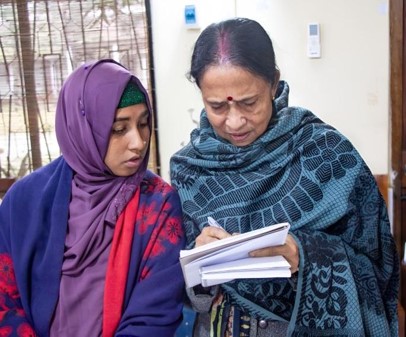 Komola shares her lessons with her counterparts
during a skill training session
Komola shares her lessons with her counterparts
during a skill training session Kamola and her team are now much better prepared. SOLIDARITY is better positioned to improve its disaster response by making it more inclusive and ensuring that the needs of people with disabilities are considered in all aspects of their work, from rescue operations to shelter arrangements. Kamola has already briefed all field-based officers on the key lessons she learned from the training, equipping them to better address the needs of persons with disabilities during disasters. She now serves as the focal point for handling all follow-up inquiries related to disability and disaster management within her organization. Thanks to a skilled and knowledgeable team member like Kamola, who has received comprehensive training on DISRE, SOLIDARITY is taking meaningful steps toward more inclusive disaster response. এখন আমার সম্পূর্ণ বিশ্বাস যে আমি দুর্যোগকালীন উদ্ধারের ক্ষেত্রে প্রতিবন্ধী ব্যক্তিদের সাহায্য করতে পারবো ( "Now, I can confidently assist people with disabilities during rescue operations)," Kamola shared. এই ট্রেনিংটা আমাদের বড় ধরনের একটি গ্যাপ পূরণ করেছে। শুধু আমার একার না, মাঠ পর্যায়ে আমার যে সমস্ত সহকর্মী আছেন, এমনকি ভলান্টিয়ার, তাদেরও (This training has filled a crucial gap, not just for me, but also for my colleagues and the volunteers who are working in the field)."
The training has also sparked a call for continued learning. During the event, officials from the MoDMR), including Deputy Secretary Mr. Asim Chandra Banik, were present. Kamola and other participants urged for regular refresher courses, with the hope that the lessons learned would be incorporated into national disaster management policies. আমরা মনে করি, এই বিষয়টি এখন পলিসি লেভেলে এসডিজির 'কাউকে পেছনে ফেলে নয়' বাংলাদেশ সরকারের এই প্রতিশ্রুতি পূরণের ক্ষেত্রেও গুরুত্ব পাচ্ছে। এটা এখন বেশ উল্লেখ করার মতো যে প্রতিবন্ধী ব্যক্তিরা দুর্যোগ প্রস্তুতিমূলক সব কাজে অন্তর্ভুক্ত হতে পারছে। ("We hope that this issue becomes a key focus at the policy level with the Bangladesh government's commitment to 'leaving no one behind' in the SDGs, it is crucial that people with disabilities are included in all disaster preparedness efforts."
Kamola's experience with the BPP training exemplifies the transformative impact of BPP's initiatives. By providing disaster management professionals with the tools and knowledge to support people with disabilities, BPP is contributing to a more inclusive and resilient disaster response framework in Bangladesh.
After receiving training, Kamola recognized the critical need to provide specialized care for people with disabilities. Previously, these individuals were not given special attention and were treated similarly to others, without considering their unique challenges. Kamola now offers tailored support, such as sharing her contact details with field staff to assist persons with disabilities, and she has instructed them based on the knowledge she gained from the training.
The SOLIDARITY team and local residents are now much more prepared because Kamola has educated herself, her colleagues and key community members involved in disaster preparedness. Now Kamola and her team are more capable of providing the necessary support, especially to persons with disabilities and their families. They now understand the importance of accessible communication, providing alternative ways to deliver warnings, and addressing the needs of individuals with mobility or sensory challenges. Kamola has shared the lessons learned from the training with her colleagues to ensure that they can provide appropriate support during emergencies so that no one is left behind or overlooked. She has also disseminated this knowledge in district, upazila, and union disaster management committee meetings to raise awareness of their responsibilities under the SOD and other relevant government policies introduced during the training.
With the ongoing support of BPP, Kamola is confident that her community will be better prepared for future disasters. She reflects, কুড়িগ্রামে আমরা প্রতিবছর বন্যা ও অন্যান্য দুর্যোগের মুখোমুখি হই। কিন্তু আমরা যারা এই যে প্রশিক্ষণটি পেয়েছি, তার এখন সমাজের সবার, বিশেষ করে সবচেয়ে যারা বেশি ঝুঁকিপূর্ণ, তাদের নিরাপত্তা ও সুবিধাসমূহ নিশ্চিত করতে ভালোভাবে প্রস্তুত।"In Kurigram, we face floods and other disasters every year. But now, with the training we have received, we are better prepared to ensure the safety and well-being of all, especially the most vulnerable."
Through the tireless efforts of individuals like Kamola and the support of programs like BPP, Bangladesh is making significant progress toward building a disaster management system that is truly inclusive and capable of addressing the needs of all its citizens, regardless of their physical abilities.
Graphs below show you the number of participant in the different
classification.
This is a statistics of participants who attended the flagship, regional
and national courses of ADPC under the data collection from the past
until May 2018.








